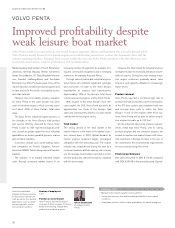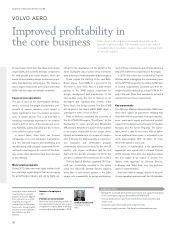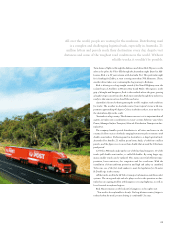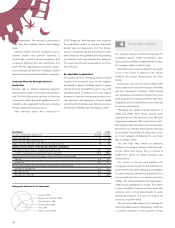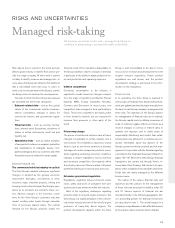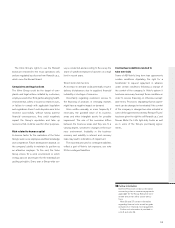Volvo 2010 Annual Report Download - page 50
Download and view the complete annual report
Please find page 50 of the 2010 Volvo annual report below. You can navigate through the pages in the report by either clicking on the pages listed below, or by using the keyword search tool below to find specific information within the annual report.
BOARD OF DIRECTORS’ REPORT 2010
Products’ environ-
mental impact
1
Cost for, access to and availability of fuel, as well
as legislation in the environmental area impacts
the Volvo Group. Problems with air pollution and
climate change entail more stringent legislations.
These are some of the factors which Volvo must
handle and its work has focused on the develop-
ment of energy-efficient engines, hybrid engines
and vehicles that can operate on alternative fuels.
Since 1975, fuel consumption in Volvo’s trucks
has decreased by approximately 40%. Over the
past 30 years, diesel engines have seen an
almost hundredfold reduction of regulated emis-
sions of nitrogen oxide (NOx) and particles (PM).
When Euro VI gains legal force in the EU in 2013,
emissions of NOx and PM will be at very low levels,
but CO2 emissions will remain.
Hybrids
The Volvo Group has a number of environmentally
adapted products in its customer offering and
future solutions that are now being tested in the
field in cooperation with customers.
The Volvo Group’s unique diesel-electric hybrid
concept, I-SAM, has made the Group the leader
in hybrid heavy vehicles. Because the Group
develops and manufactures solutions, this facili-
tates coordination and optimization of products
and components to produce the most efficient
driveline. The Volvo Group’s development program
comprises city buses and distribution trucks, as
well as construction equipment. Measurements
on customers’ hybrid buses show significantly
lower fuel consumption of up to 35%, corres-
ponding to the same reduction of CO2 emissions,
strongly reduced emissions of PM, which generate
cleaner air, and also lower noise levels since diesel
engines switch off at bus stops.
Alternative fuels
Three years ago, the Volvo Group presented
seven different demonstration vehicles that can
all be driven without net emissions of climate-
impacting carbon dioxide. This resulted in a
development project pertaining to two of the
alternatives: methane diesel and DME (dimethyl-
ether). The benefit of methane diesel technolgoy
is that methane fuel already today is available as
a fuel for vehicles. Trucks, buses, construction
equipment and industrial engines are being field
tested and sales of trucks with methanediesel-
engines is planned to begin in 2011. BioDME is
currently available only on a small scale in the
market. Since the Volvo Group believes that this
EPA 2010
EPA 2007
0,16
0,14
0,12
0,10
0,08
0,06
0,04
0,02
0,00
Particles, g/kWh
NO
x, g/kWh
0 1 2 3 4 5 6 7 8
Euro II, 1996
Euro III, 2002
Euro IV, 2006
Euro V, 2009
EPA 2002
In September 2009, Euro V was implemented in
Europe and in January 2010, EPA 2010 was
implemented in North America. Euro V entails a
50% reduction of NOx emissions compared to Euro
IV. With the implementation of EPA 2010, emission
levels for particulates and NOx are close to zero.
Euro VI, 2013
Emissions regulations for trucks and buses
fuel is the most energy-efficient from a lifecycle
perspective, Volvo plays an active role in the
BioDME project. The aim of the project is to
involve the entire chain from the production and
distribution of BioDME, to it being used as fuel in
vehicles. The project is financed by the EU and
the Swedish Energy Agency. Volvo’s portion of
the project is to be project coordinator and to
build vehicles for field testing.
Cooperation with WWF
The Volvo Group has a vision that future transport
will be CO2 neutral. As part of this, the Volvo
Group was the first manufacturer in the automo-
tive industry to be affiliated with WWF’s Climate
Savers. As a participant in WWF’s program, the
Volvo Group’s truck company undertakes to
reduce CO2 emissions from vehicles produced
between 2009 and 2014 by 13 million tons,
which corresponds to Sweden’s total emissions
for three months. Independent technical experts
will review the results.
46


